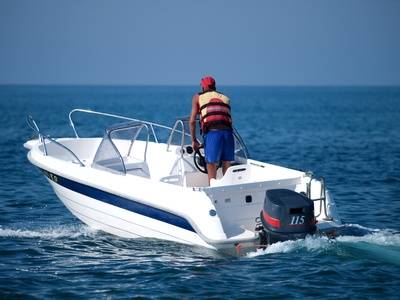
Boats cruise most efficiently when they ride upon a cruising plane, where the hull produces the least amount of friction for the maximum RPM. Transom tilt, or trim setting relies on the tilt position of the motor in its relation to the horizontal plane of the engine. Transom tilt can be set high or low, depending upon the owner's preference. The ideal tilt-trim setting allows for the best boat profile for comfort, the highest speed for cruise and the best fuel economy. Outboard engines have control settings on the engine mount that allow for mechanical adjustment, or electronic controls and hydraulics to control the trim.
Board your boat with the average load of passengers and gear that you take on outings. Distribute the passengers and gear evenly in the boat so it has no side-to-side lean. Drive the boat out into open water in calm water. Increase the throttle speed until it reaches normal cruising plane, where the hull skips effortlessly over the water. Write down the numbers that appear on your speedometer and tachometer. Note whether the hull rides a little high or too low.
Stop the boat and let it idle. For a motor smaller than 30 HP, you will probably have a mechanical adjustment bracket near the engine mount. Look at the long pin shaft that runs through the bracket. There will be about six adjustment holes on the bracket. Pull the spring-locking pin out of the end of the pin shaft and pull the pin shaft out of the bracket. Tilt the engine up or down to align a different hole location. Place the pin shaft back in the bracket and secure the locking pin.
Drive the boat up to plane speed again and look at the speedometer and tachometer numbers. If the speedometer number has increased and the tachometer number has decreased, it means you have improved the trim-tilt by making the engine work less to achieve the same plane speed. If speed has decreased, you must make another adjustment. To raise the bow, tilt the engine toward the transom one notch on the bracket. To lower the bow, tilt the engine away from the transom by a notch.
Drive the boat through some heavy chop or rough seas with a normal load, with your newly adjusted trim-tilt setting. Drive directly into the waves and note if too much spray flies over the bow and wets the passengers and interior. If so, you must adjust the trim-tilt for more "Trim Out," which will raise the bow. Pull out the adjusting pin shaft and tilt the engine away from the transom one notch and replace the adjusting pin shaft. This adjustment will afford you the best position for regular performance and rough seas.
Drive your boat with your normal passenger load and head out into calm water. For a boat that has a 30-HP or larger engine, equipped with an electric trim-tilt and hydraulic system, accelerate to your regular planing speed at cruise. Push your trim-tilt button for either "Trim In" or "Trim Out." You want to reach the fastest plane speed with the least RPM. Experiment until you find the correct setting.
Consult your boat owner's manual for performance criteria regarding your trim-tilt setting. See if your adjustment and tilt angle matches or comes close to the recommended setting. Keep in mind that the recommended maximum passenger and gear load weight, so you do not exceed. it.